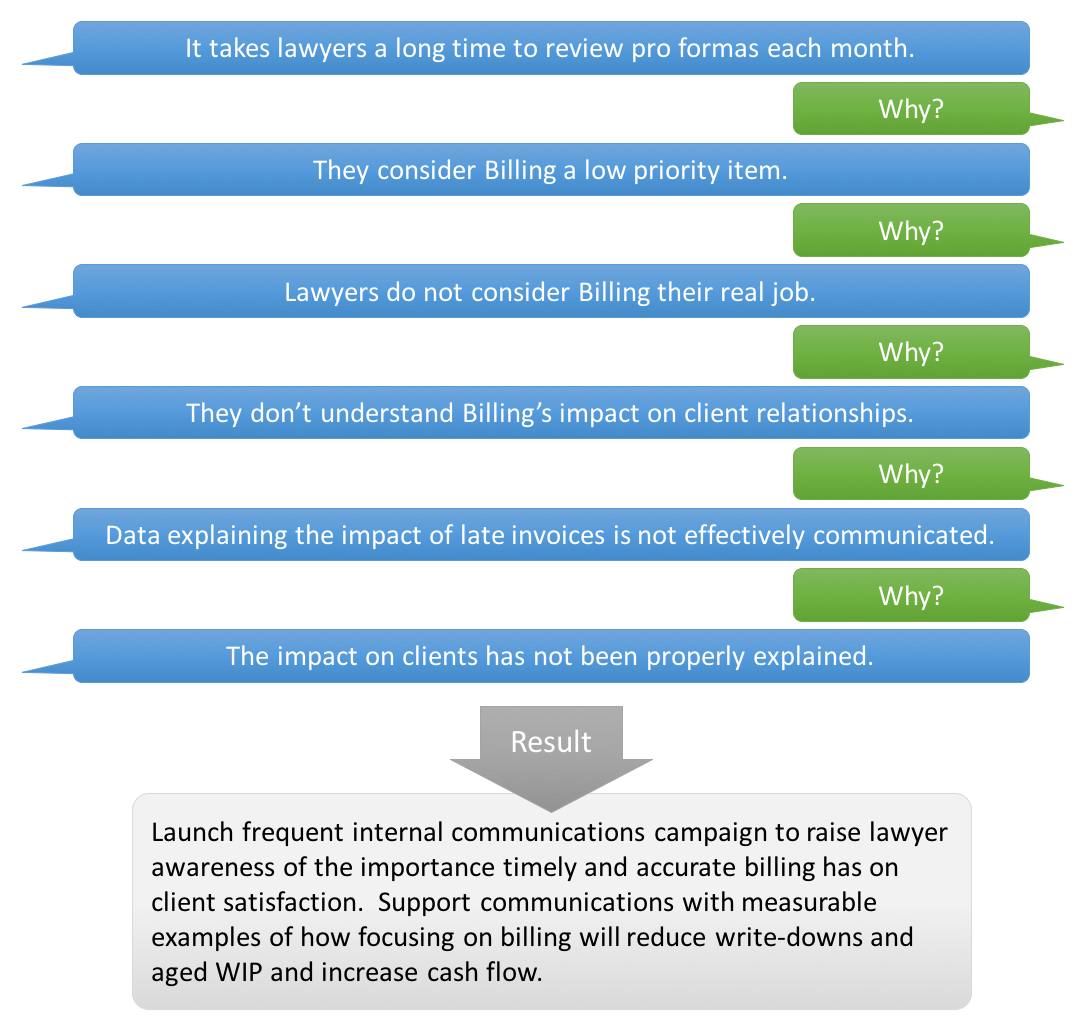How a Lean Billing Practice Can Improve Cash Flow, Part 2
December 03, 2019
Applying Lean to Transform Law Firm Billing from a Support Function to a Solution Center
Another stressful month-end is over. You survived, but not without experiencing the negative impact on cash flow associated with clients writing-off or delaying payment. It’s becoming increasingly difficult to efficiently process accurate invoices while complying with client and lawyer requests, so you’ve decided to look at these billing issues through formal process improvement techniques. Maybe this decision stemmed from reading a compelling blog post entitled “How a Lean Billing Practice Can Improve Cash Flow,” or a partner suggesting you read it. Whatever the reason, you just want next month to be different.
So where do you start? You want to make an immediate impact, so multi-year training isn’t feasible by next month-end, but this shouldn’t stop you from applying some basic Lean methods to your work. In this post we will highlight a few key tools to kick start your process improvement initiatives and create cash flow growth during the next billing cycle.
Soon, you will have measurable improvement results for your management team and clients, and your life will be a bit less stressful.

“DMAIC” Decoded
One of the most commonly used Lean frameworks is DMAIC (pronounced də-MAY-ick). This acronym stands for Define, Measure, Analyze, Improve and Control, and is a process improvement cornerstone. DMAIC allows you to prioritize billing process improvements by analyzing data, rather than solely focusing on the “squeaky wheel” or loudest complaint. Since these days our tolerance for learning yet another acronym is very low, the key is to understand the concepts of DMAIC but to deliver them to your team in a simple and approachable way.

Define
DMAIC first requires you to Define the process, the problem, and the goal.
To define your billing process, you will benefit from a process workflow map. These are visual representations of your process that enable you to identify areas of concern and pinpoint where improvements will have the greatest impact.
Do not overlook this first step. Your initial inclination might be that you and your team fully understand the billing process, however, differences in understanding of the current billing process are often only realized when the team creates and reviews a process map together.
Don’t know where to start with process workflow mapping? Use our example below:

Once you have a process map in hand, it’s much easier to identify issues within specific parts of the process. After you have identified these issues, you can then define a Problem Statement.
The Problem Statement serves several purposes. First, it significantly clarifies the current situation by specifically identifying the problem and its severity, location, and financial impact. It also serves as a great communication tool, helping to get buy-in and support from others. When Problem Statements are well written, people can more easily understand what you’re trying to accomplish.
For example, let’s say that you decide you want to tackle delays in the time it takes lawyers to review proformas and provide edits. An example of a quality Problem Statement might be:
The average time it takes a lawyer to review proformas and provide edits to Billing is 13 business days. Approximately 20% of proformas requiring lawyer review are returned to Billing after the monthly deadline. Write-offs stemming from client rejections account for 10% of the total amount billed.
Delays in the billing process often result in errors that lead to write-downs before the client is invoiced. They can also result in significant amounts of work in progress (“WIP”), or time worked but not billed, that becomes increasingly difficult to invoice as it ages. Inaccurate or late invoices result in write-offs due to non-compliance with client billing guidelines, which in turn impacts collections and cash flow.
Based on the Problem Statement created after reviewing your process map, you might decide your goal is to reduce average review time by 20%. This is certainly a noble goal, but how will you define success? You must establish relevant measurements that will allow you to monitor progress towards your goals.
Once everyone understands the problem and your goals, you need to Measure the current state.

Measure
This can be challenging, because not everyone will warmly embrace the effort needed to collect the data required to complete this phase effectively. For example, you might decide that you need to accurately track when proformas are sent to lawyers for review and when they were returned to Billing. Persevere! As the saying goes “You can’t manage what you can’t measure.” You will need these measurements in order to show the impact of the improvements.
Below are a few measures aimed at tracking your progress towards your goal to reduce average lawyer review time and increase cash flow:
- Aged Work in Progress – The amount of unbilled time worked
- Realization – The percentage of time worked and billed that was paid by the client
- Bill Speed – Time from proforma generation to invoice posting
- Edit Speed – Time from proforma generation to receipt of edits from legal team
- Re-Review Incidents – Count of proformas returned to legal team after editing for additional review and approval
- Turnaround Time – Time from receipt of edits to invoice posting
Once you have your measurements, you can Analyze the data you have collected. The goal is to narrow down and verify root causes.

Analyze
During the Analyze phase, you might want to identify the root cause by using the “5 Whys” technique. This technique (asking the question “Why?” five times) is commonly used to explore and better understand the cause and effect relationships of problems.
By asking the following five questions, you can begin to better understand the causes of delays in the review process, and the real underlying reasons why these delays occur. Equipped with this information, you can begin to identify opportunities to improve the process, reduce the time it takes lawyers to review bills, and increase cash flow.
The Five Whys

Conclusion
First you Define the billing process using a detailed process map to identify the problem your law firm needs to address, such as the need to reduce the time it takes lawyers to review and submit proformas.
Then you establish quantifiable goals by which your team can Measure performance, such as reducing lawyer review time by 20% to improve cash flow.
Next, you Analyze the root causes affecting your ability to meet your desire goals.

Armed with this information about your billing issues, you can propose and implement efforts to Improve your process and develop ways to Control the process to ensure that your improvements are maintained. Once you have tackled your first problem using this methodology, you can use the same tools to improve other points in the process, or in different processes.
Back to Expertise

